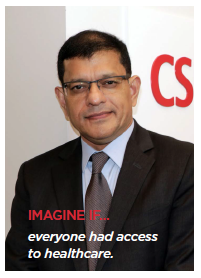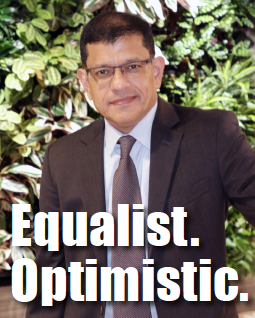 Ryan Saadi, M.D., MPH
Ryan Saadi, M.D., MPH
Title: Global VP, Evidence, Market Access, Strategic Pricing
Company: CSL Behring
Industry Awards: PharmaVOICE 100, 2011, 2015
Associations: Voting Member, Medicare Evidence Development & Coverage Advisory Committee, Centers for Medicare and Medicaid Services
In everything he does, Ryan Saadi, M.D., is always ready to challenge the status quo and siloed thinking within the life-sciences industry with irrefutable logic and to start initiatives to improve organizations and decision-making.
As global VP for evidence, market access and strategic pricing, at CSL Behring, Dr. Saadi focuses on developing teams to solve problems by considering the near- and long-term issues against the immediate challenge. Before joining CSL, just about a year ago, Dr. Saadi spent 10 years at Johnson & Johnson, most recently as global head, market access (health economics, reimbursement, RWE) and policy, oncology.
Over his career in the industry, he has amassed vast experience from different therapeutic areas, different policy areas, and different geographies. His creative approach to problem-solving has kept him at the forefront of global innovation, and he has fostered tools and solutions that have been key for the industry, such as treatment comparisons for single-arm trials and toolkits for consistent value proposition and customer experience.
Several areas where Dr. Saadi has consistently shined are his ability to discern and foster talent and his focus on gender equality, which make him an inspiration and mentor to many. He stands up against discrimination of any sort. He not only recognizes talent regardless of gender, he isn’t afraid to confront old attitudes that do not serve good business decisions. Dr. Saadi bristles at the idea that you can judge intelligence or potential based on gender. Colleagues say his ability to reward merit and challenge the “old boys network" are refreshing and admirable.
PV: How do you strive to drive innovation and transformation at CSL Behring and in the industry?
Saadi: Innovation, much like the ability to see any transformational change, occurs naturally in the right conditions — a workplace that is open to improving performance and inclusive of novel ideas that bring efficiency. At CSL Behring, innovation is foundational to our culture; it’s highly valued, and is one of the reasons I joined the company. My goal with my team is to continue to create an adaptive environment where my colleagues are comfortable being themselves and feel supported to aim for ambitious goals even when that means changing the way things have always been done.
PV: What is your vision for innovation in terms of what you’re doing within your group at CSL Behring?
Saadi: Traditionally in this industry, innovation is thought of in terms of medical technology. But if we create an environment that encourages innovation this will lead to transformation. To create an environment that drives ideas requires a shift in mindset and that means we have to accept that everyone is different and thinks differently. The idea is to cultivate an environment where people can come up with unbelievable ideas. We also need to create a culture where it’s okay to fail and make mistakes. The thing about failing means you’ve tried so we should reward failure and encourage people to try again.
PV: How do you believe collaborations across the ecosystem will impact innovation and drive improvements from R&D through commercialization?
Saadi: Ideas from outsiders are the only way to accelerate innovation. Our ecosystem must go beyond collaborations between ourselves within the healthcare ecosystem. At CSL Behring, we think a lot about how we can better interact with patients through collaboration with the digital technology industry, for instance sharing health data from wearables, collecting patient experience in apps, and customizing the delivery of medicine aligned to input from patients. We also have numerous collaborations with academia to further our knowledge, ways of thinking, and to spur continued innovations with the aim of improving patient care.
PV: What do you think the future of the life-sciences industry will be like?
Saadi: I imagine patients will continue to be empowered to drive the R&D agenda and direct decisions at each step in the market access process. In fact, this is already happening today. We routinely hold multi-stakeholder meetings so that we can design studies to capture outcomes that patients care about and bring together regulators and payers to better understand how to value these innovations. In my future world, all stakeholders will work even closer to tackle global public health challenges and redesign our healthcare institutions to truly promote health rather than illness care.
PV: You have spoken about access to healthcare. Why is this important to you?
Saadi: Part of my background is in public health and access to healthcare is a major issue in the United States. A significant portion of Americans are either under-insured,  uninsured, or can’t afford other expenses even when they are fully insured. As an example, a portion of Medicare patients who are diagnosed with cancer can’t afford the out-of-pocket cost of their treatment. These are hardworking people, who have paid taxes their whole lives. For many upon a cancer diagnosis, they don’t follow the treatment protocol because they can’t afford it, and by doing that, they are basically accepting a death sentence. This is a public health crisis, an outcome of unsuitable coverage design. It’s extremely important to me because what’s the point of doing all this research if our fellow human beings can’t have access to live-saving medicines.
uninsured, or can’t afford other expenses even when they are fully insured. As an example, a portion of Medicare patients who are diagnosed with cancer can’t afford the out-of-pocket cost of their treatment. These are hardworking people, who have paid taxes their whole lives. For many upon a cancer diagnosis, they don’t follow the treatment protocol because they can’t afford it, and by doing that, they are basically accepting a death sentence. This is a public health crisis, an outcome of unsuitable coverage design. It’s extremely important to me because what’s the point of doing all this research if our fellow human beings can’t have access to live-saving medicines.
PV: If you had unlimited resources, what industry challenges would you fix and how would you fix them?
Saadi: Limited resources are good for the industry in the sense that they require decision-makers to carefully select our investments. The one area where this is not ideal is in developing innovation for regions with very limited resources themselves.
Unfortunately, given the financial demands of medical innovation, it can be difficult to justify investments in solutions specifically for areas of the world that may not have stable healthcare systems or where the cost of developing the solution will be greater than the affordability. There are foundations with this focus; however, more can be done. With unlimited resources, my goal would be to support the development of strong public health systems globally, to create new incentives, and encourage novel pathways to accelerate health innovation and access for the most underserved populations.
PV: How do you believe your leadership style inspires others to reach their personal and professional goals?
Saadi: I empower others by letting them know that I care. Believing in my team members means that I try to inspire each person to follow his or her passions and know that only self-doubt can place limits on the potential to achieve a goal.
PV: How important is it for you to mentor and develop the next generation of leaders?
Saadi: It’s critical to mentor and develop all employees. Our global public health system is dependent on continuous medical innovation. Without an efficient, passionate, and thoughtful workforce among all sectors of healthcare, the process of innovation will be at risk. I consider developing future leaders as my responsibility to society. Without proactive intervention and mentorship, talent may be missed and a potential future innovator may not get the opportunity to contribute. As an example, most terminal degree holders in health sciences are women, yet very few women in our industry are mentored and provided with the experiences necessary to ascend to the highest levels of contribution, such as executive leadership roles or board directors. The next generation of leaders will revolutionize how we think about and tackle our greatest health challenges.
We require various perspectives to catalyze new ideas and novel solutions. My highest priority is to mentor the brightest young professionals and to provide these individuals with the opportunity to develop into tomorrow’s leadership.
PV: Why is gender equality important to you?
Saadi: Today, more than 70% of Ph.D.s in the health sciences are women. If a company, or industry, wants to stay in business and keep growing, talent management should be a top priority. We must adjust our culture to attract a new pool of talent. I think we’re behind already, and it worries me because that means that we are not actually creating a structure that will be sustainable.
PV: As a leader, what is the one thing that keeps you up at night? Conversely, what’s the one thing that brings you joy?
Saadi: One thing that keeps me up at night is the misguided perception that critical, often negative feedback is necessary to improve performance. When I think about how much my generation needs the insight of the millennials and the following generations who will be our next leaders, I fear that current management philosophies may risk alienating this key source of talent. My daughter Emily brings happiness to my life and in her, I sense the needs of the younger generation. She puts the top priority on finding her life’s passion; this makes me proud in the same way seeing my mentees reaching their highest ambition is a source of joy. As leaders, it is our role to motivate our mentees with fulfilling assignments that play to their strengths.
PV: What mark would you like to leave on the industry as your legacy?
Saadi: We need to shift the mindset of all healthcare stakeholders from negotiation to collaboration — we are the manufacturers, doctors, health providers, government institutions, and payers who can and do improve the lives of millions. Thus, we can and must collaborate to accomplish our common goal of improving health.(PV)



















